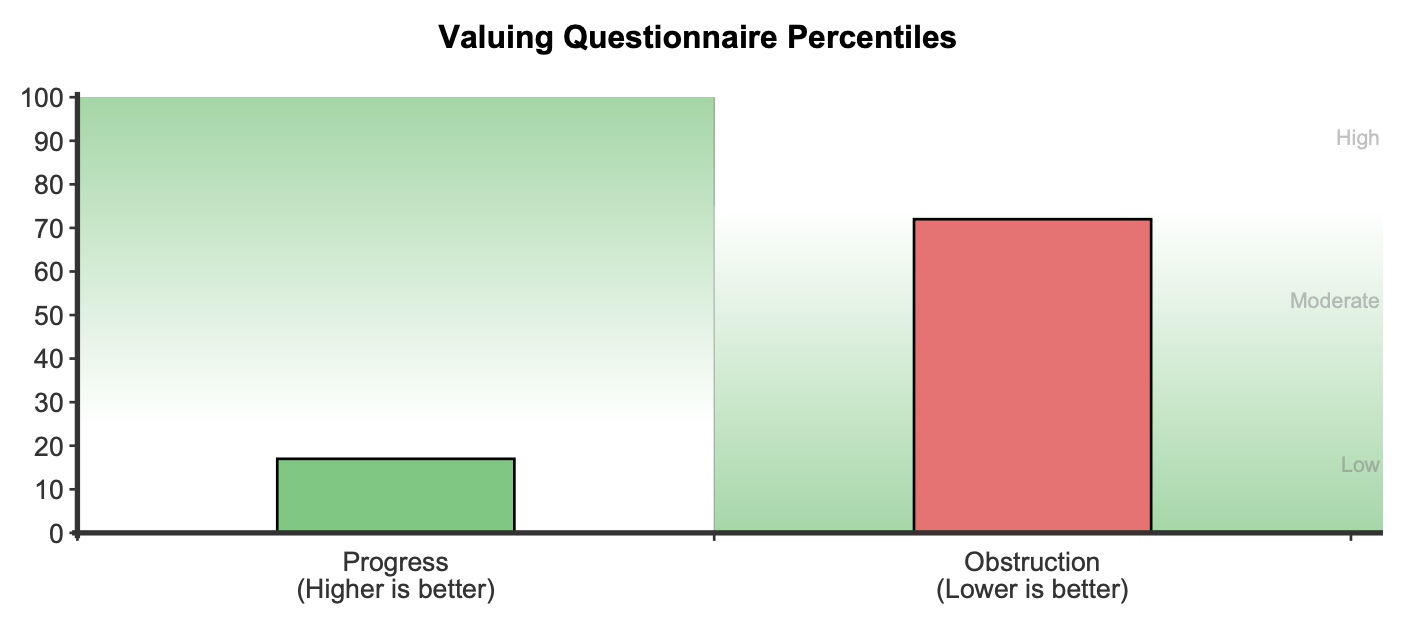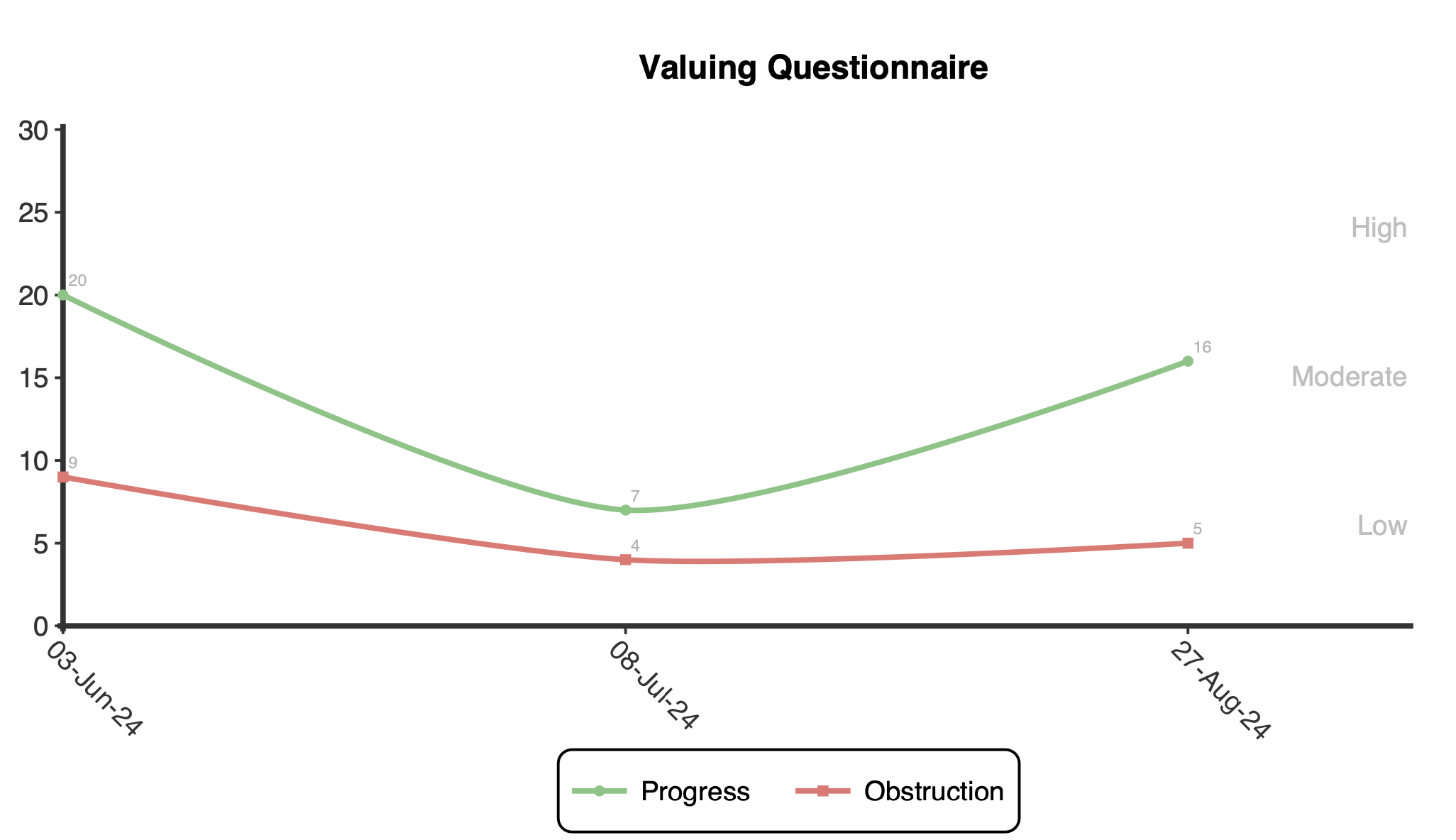The Valuing Questionnaire (VQ) is a 10-item self-report scale designed to measure how consistently an individual has been living with their self-determined values and is particularly helpful when administered during a course of ACT.
Two subscale scores are presented, Progress and Obstruction, which typically have a negative correlation.
– Progress (items, 3, 4, 5, 7,9. Range = 0 to 30) defined as enactment and perseverance in living consistently with one’s values. Higher scores represent a closer alignment between one’s internal values and one’s actions.
– Obstruction (items 1, 2, 6, 8, 10. Range = 0 to 30) represents the extent to which various disruptions got in the way of valued living. Higher scores represent more interference with living consistently with one’s values.
Scores indicative of psychological health are high scores on the Progress scale accompanied by low scores on the Obstruction scale.
As well as raw scores being presented, percentile ranks compared to an undergraduate university (community) sample are presented. A percentile of 50 on the community sample on each subscale represents a typical score for people within this sample of undergraduate university students (mean age = 20.4, SD = 4.5). The percentiles ranks also determine the descriptions:
– 0 – 25th percentile: “Low values engagement” on the Progress subscale and “Low fusion & avoidance” on the Obstruction subscale
– 26th – 74th percentile: “Moderate values engagement” on the Progress subscale and “Moderate fusion & avoidance” on the Obstruction subscale
– 75th percentile and above: “High values engagement” on the Progress subscale and “High fusion and avoidance” on the Obstruction subscale
When used as a monitoring tool during a course of ACT, successful treatment is indicated by increasing Progress Scores and decreasing Obstruction Scores.
If administered more than once results are graphed over time, indicating progress in treatment. A helpful way to explain “success” to clients is when progress scores are higher than obstruction scores.
A meaningful change (~ 0.5 SD) in score is defined as an increase or decrease of at least 3 or more points for each subscale. This criterion is based on the Minimally Important Difference (MID) calculation. Such changes indicate meaningful improvement or deterioration in Progress or Obstruction, while a change of less than the specified points suggests no meaningful change in Progress or Obstruction between assessments.
Sample VQ Questions:
Two subscale scores are presented, Progress and Obstruction, which typically have a negative correlation.
 Scores indicative of psychological health are high scores on the Progress scale accompanied by low scores on the Obstruction scale.
Scores indicative of psychological health are high scores on the Progress scale accompanied by low scores on the Obstruction scale.
As well as raw scores being presented, percentile ranks compared to an undergraduate university (community) sample are presented. A percentile of 50 on the community sample on each subscale represents a typical score for people within this sample of undergraduate university students (mean age = 20.4, SD = 4.5). The percentiles ranks also determine the descriptions:

When used as a monitoring tool during a course of ACT, successful treatment is indicated by increasing Progress Scores and decreasing Obstruction Scores.
If administered more than once results are graphed over time, indicating progress in treatment. A helpful way to explain “success” to clients is when progress scores are higher than obstruction scores.

A meaningful change (~ 0.5 SD) in score is defined as an increase or decrease of at least 3 or more points for each subscale. This criterion is based on the Minimally Important Difference (MID) calculation. Such changes indicate meaningful improvement or deterioration in Progress or Obstruction, while a change of less than the specified points suggests no meaningful change in Progress or Obstruction between assessments.
While developing the measure, Smout et al. (2014) conducted factor analyses that supported a 2-factor solution in undergraduate university student (n= 630) and clinical adult (n= 285) samples. The clinical sample was from an outpatient CBT treatment clinic in Australia whereas the undergraduate university sample were primarily young (M=20.4, SD=4.5), Caucasian (68%, 21.6% were Asian), and full-time (92%) in the first year of their degree (87%) with English as the language spoken at home (80.8%). Most were also engaged in casual or part-time work (51%) but 45% were not working at all.
As one would expect, there was a negative correlation (r=-.66) between the two factors and there was a pattern of different responses between the normative undergraduate sample and the clinical sample. For the Progress Subscale, scores were significantly lower in the clinical sample (M=12.8, SD=7.91) compared with the university sample (M=17.2, SD=6.44). The clinical sample had higher scores on the Obstruction subscale (M=18.9, SD=6.49) compared to the university sample (M=12.1, SD=6.88), indicating the clinical sample had more problems living consistently with their values. In the same study concurrent validity was established via comparison with the Satisfaction With Life Scale (SWLS), the Valued Living Questionnaire (VLQ), and the Acceptance and Action Questionnaire (AAQ-II).
The percentiles presented for the VQ are for the community sample. These percentiles are also used to provide a descriptor based upon the following:
Smout, M., Davies, M., Burns, N., & Christie, A. (2014). Development of the valuing questionnaire (VQ). Journal of Contextual Behavioral Science, 3(3), 164-172.
NovoPsych’s mission is to help mental health services use psychometric science to improve client outcomes.
© 2023 Copyright – NovoPsych – All rights reserved